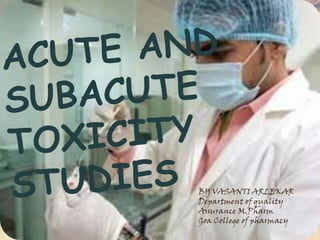
Subacute toxicity
- 1. BY VASANTI ARLEKAR Department of quality Assurance M.Pharm Goa College of pharmacy
- 2. TOXICOLOGICAL STUDIES Single dose or multiple dose in single day 1.Acute toxicity study 2.Acute irritation Repeated dose 1.Sub-acute (28 days) 2.Sub-chronic (90 days) Genotoxicity 1.Micro Nucleus Test (MNT) Reproduction toxicity 1.One generation Allergenicity 1.Guinea pig maximization test (GPMT) 2.Mouse ear swelling test (Test)
- 3. INTRODUCTION Acute toxicity studies in animals are usually necessary for any pharmaceutical intended for human use. The information obtained from these studies is useful in choosing doses for repeat-dose studies, providing preliminary identification of target organs of toxicity and, occasionally revealing delayed toxicity. Acute toxicity studies may also aid in the selection of starting doses for Phase 1 human studies, and provide information relevant to acute overdosing in humans.
- 4. ACUTE TOXICITY DEFINITION Acute toxicity is the toxicity produced by a pharmaceutical when it is administered in one or more doses during a period not exceeding 24 hours. Single escalating doses are given to small grps of animals and the animals are observed for overt effects and mortality. The LD 50 dose is calculated (the dose req to kill 50% of the population)
- 5. MTD ISSUE The Maximum Tolerated Dose is defined as the highest dose of a chemical or drug that can be administered for the animal’s life without causing excessive toxicity of decreasing survival (except due to tumor induction).
- 6. OBJECTIVES To determine the Median Lethal Dose (LD50) after a single dose administered through one or more routes, one of which is the intended route of administration in humans. To determine Maximum Tolerated Dose (MTD) and No Observable Effect Level (NOEL). To identify potential target organs for toxicity, determine reversibility of toxicity, and identify parameters for clinical monitoring. To help select doses for repeated-dose toxicity
- 7. Acute Toxicity Studies Single dose - rat, mouse (5/sex/dose), dog, monkey (1/sex/dose) 14 day observation In-life observations (body wt., food consumption, clinical observations) Necropsy and histopathology Clinical pathology
- 8. Acute LD50 Values vs. Toxicity Chemical LD50 (mg/kg) Toxicity ______________________________________ _________________ _________________ Sodium chloride 4000 Slightly toxic DDT 100 Moderately toxic Picrotoxin 5 Highly toxic Strychnine 2 Nicotine 1 Dioxin 0.001 Super toxic Botulinum toxin 0.00001
- 9. The Draize Test acute toxicity test The procedure involves applying 0.5mL or 0.5g of a test substance to the eye or skin of a restrained, conscious animal, and leaving it for 4HRS. The animals are observed for up to 14 days, for signs of erythema and edema in the skin test, and redness, swelling, discharge, ulceration, hemorrhaging, cloudiness, or blindness in the tested eye. The test subject is commonly an albino rabbit, dogs. The animals are killed after testing.
- 10. TESTING PROCEDURES The test compound should be administered to animals to identify doses causing no adverse effect and doses causing major (life-threatening) toxicity. The use of vehicle control groups should be considered. For compounds with low toxicity, the maximum feasible dose should be administered. Acute toxicity studies in animals should ordinarily be conducted using two routes of drug administration:
- 11. (1) The route intended for human administration (2) intravenous administration, if feasible. When intravenous dosing is proposed in humans, use of this route alone in animal testing is sufficient. Studies should be conducted in at least two mammalian species, including a non rodent species The objectives of acute studies can usually be achieved in rodents using small groups of animals (for instance, three to five rodents per sex per dose) Where non rodent species are appropriate for investigation, use of fewer animals may be considered
- 12. OBSERVATIONS Animals should be observed for 14 days after pharmaceutical administration All mortalities , clinical signs, time of onset, duration, and reversibility of toxicity should be recorded Gross necropsies should be performed on all animals, including those sacrificed moribund, found dead, or terminated at 14 days
- 13. In addition to the above observations can even be made as to which one amongst a group of expected compounds is the most efficient one to produce the desired effect (i.e the lead comp) which can be studied by analyzing the DRC curves and pharmacokinetic data obtained.
- 14. REPEATED DOSE TOXICITY STUDIES Repeated doses are given to animals for 2 – 12 weeks on the duration of intended treatment in man. Doses are selected on the basis of ED 50 and LD50 Animals are observed for overt effects , food intake , hematology, body wt and organ toxicity.
- 15. SUB ACUTE TOXICITY OBJECTIVES To determine toxicity after repeated administration of the test material. To help establish doses for sub chronic studies
- 16. Sub acute toxicity studies Duration 14 days to 90 days Test System/Animal System 2 species required. Mice, rats, rabbits, guinea pigs, dogs. Dose Administration 3 to 4 doses given by the same routes as previous toxicity
- 17. oThe following routes are commonly used: Oral Dermal Inhalation Intravenous Intraperitoneal Other protocal specified route Parameters Mortality Weight change Signs of toxicity Clinical pathology Pathology and histopathology
- 18. In vivo toxicological models
- 19. Sub acute toxicity test uses laboratory strains of young healthy adult rats The study is performed at 4 dose levels (high, mid, low and vehicle) and there are 5 rats/sex/group The test compound are administered daily for 14 days via one of the route of administration (PO, IP, IM or SC) or the route intended for human administration. The animals are observed individually after dosing, periodically during the 24 hours, and daily thereafter for 14 days
- 20. observation : Observations are recorded systematically for each animals for clinical sign. Body weight, food consumption and water intake is measured once a week. . Baseline and day 14 serum chemistry and hematology are recorded. Gross necropsy and organ weight are measured at the end of study.
- 22. THANK YOU